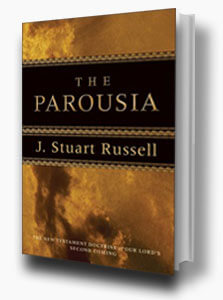- Table of Contents
- About the Author
- Preface to the Book
- The Last Words in Old Testament Prophecy
- PART I. - The Parousia in the Gospels
- Parousia in the Synoptical Gospels
- Prophetic Intimations of the approaching Consummation of the Kingdom of God:
- The Prophecy on the Mount examined:
- Our Lord's declaration before the High Priest
- Prediction of the Woes coming on Jerusalem
- Prayer of the Penitent Thief
- Apostolic Commission, the
- The Parousia in the Gospel of St.John.
- Appendix to Part I
- PART II. The Parousia in the Acts and the Epistles.
- In the Acts of the Apostles.
- In the First Epistle to the Thessalonians
- In the Second Epistle to the Thessalonians
- In the First Epistle to the Corinthians
- In the Second Epistle to the Corinthians
- In the Epistle to the Galatians
- In the Epistle to the Romans
- In the Epistle to the Colossians
- In the First Epistle to Timothy
- In the Second Epistle of Timothy
- In the Epistle to Titus
- In the Epistle to the Hebrews
- In the Epistle of St. James
- In the First Epistle of St. Peter
- In the Second Epistle of St. Peter
- In the First Epistle of St. John
- In the Epistle of St. Jude
- Appendix to Part II
- Part III. The Parousia in the Apocalypse.
- Summary and Conclusion
- Appendix to Part III.
- Afterword by Russell
- All the Comparative Scripture Charts Combined
THE PAROUSIA
by James Stuart Russell
THE PAROUSIA IN THE EPISTLE TO THE GALATIANS.
We find no direct allusion to the Parousia in the Epistle to the Galatians. It contributes, however, indirectly to the elucidation of the subject, by furnishing an illustration of the early appearance and rapid growth of that defection from the faith predicted by our Lord, and designated by St. Paul ‘the apostasy,’ or ‘falling away,’ which was a sign and precursor of the Parousia. (See Matt. 24:12; 2 Thess. 2:3; 1 Tim. 4; 2 Tim. 3, 4:3, 4) The plague had already broken out in the churches of Galatia, and we see in this epistle how earnestly the apostle endeavoured to check its progress, vehemently protesting against this perversion of the Gospel, and denouncing its originators and propagandists as enemies of the cross of Christ. The evil arose from the arts of the Judaising teachers, who were everywhere the inveterate opponents of St. Paul, and who seem to have been possessed with the same spirit of proselytism which distinguished the Pharisees, who ‘compasses sea and land to make one proselyte.’ In this manifestation of the predicted apostasy we have a marked indication of the approach of the ‘last times,’ or ‘the end of the age.’
‘THIS PRESENT EVIL AGE, OR ÆON.’
Gal. 1:4—‘Who gave himself for our sins, that he might deliver us from this present evil world.’
The apostle here speaks of the existing state of things as evil, and of the Lord Jesus Christ as the deliverer therefrom. The word age [aiwn] does not of course refer to the material world, the earth; but to the moral world, or age. It is equivalent to the phrase so often occurring in the gospels, ‘this wicked generation’. Matt. 12:45, etc. ‘The present evil age’ is regarded as passing away, and about to be succeeded by a new order, the aiwn o mellwn. (Heb. 2:5)1
THE TWO JERUSALEMS—THE OLD AND THE NEW.
Gal. 4:25, 26—‘For this Agar is mount Sinai in Arabia, and answereth to Jerusalem which now is, and is in bondage with her children. But the Jerusalem which is above is free, which is the mother of us all.’
It is not our intention at present to do more than simply take note of this remarkable contrast between the two cities, the new and the old Jerusalem. We purposely refrain at this stage from entering upon symbols and their significance, until the whole subject comes before us in the Book of Revelation.
In the meantime the reader is requested to note well the contrasts here presented. The Jerusalem which now is, and the Jerusalem which is to be; the earthly Jerusalem, and the heavenly Jerusalem; the Jerusalem which is in bondage, and the Jerusalem which is free; the Jerusalem which is beneath, and the Jerusalem which is above, the Jerusalem which is the mother of slaves; and the Jerusalem which is our mother. We shall yet find this contrast of no little use in determining the meaning of some of the symbols in the Apocalypse.








Comments